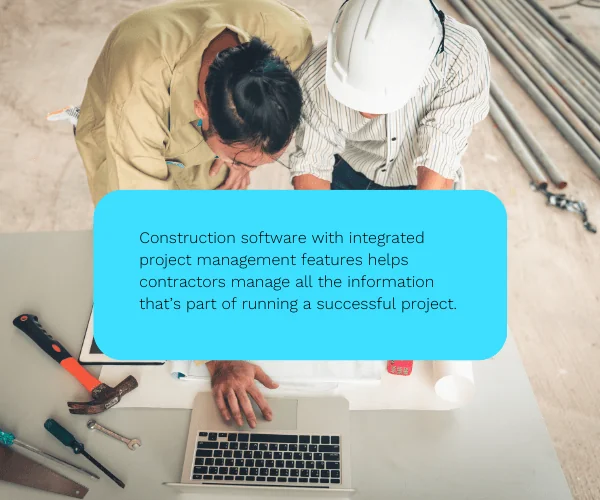Boost Project Management with Construction ERP Software
Using ERP software can enhance efficiency in construction project management. Here’s how:
-
Centralized Data: Keep all project information in one place. This makes it easy to access and share data.
-
Improved Collaboration: Team members can communicate better. This helps prevent misunderstandings and delays.
-
Real-Time Tracking: Monitor project progress as it happens. Quick updates let you address issues immediately.
-
Resource Management: Use resources wisely by tracking their usage. This can reduce waste and save money.
-
Budget Control: Stay on top of costs with accurate budgeting tools. This helps avoid overspending.
-
Task Automation: Automate repetitive tasks to save time. This lets your team focus on important work.
By integrating ERP software, construction projects can run smoother and more efficiently.
Efficient project management in construction is the foundation of a successful company. Preventing cost overruns and missed deadlines will save you money and ensure your customers are happy.
ERP software with project management features helps construction managers track job performance. It offers tools that display important details about your project. You can easily see updated information on budgets, labor hours, materials, and equipment resources.
In this blog, we’ll show how project management for construction software helps streamline processes, make smarter decisions, and save time and money.
Understanding the Challenges in Construction Project Management
Every construction project has its own challenges. Most project managers face three main issues: scheduling resources, managing materials, and sharing updates.
If you’re like most contractors, you’re running multiple projects simultaneously. That means you must carefully balance the use of resources like heavy equipment and ensure your investments are used efficiently. This way, your jobs won’t be delayed when equipment goes to another site. Make sure you schedule labour teams and subcontractors at each stage of the job. That way no one is waiting around or adding idle days to the cost of the project.
Successful project execution relies on clear communication among contractors, suppliers, subcontractors, and project teams. Make sure the right teams are on site at key times. Also, ensure they have the materials and tools needed to do their jobs.
And when you work on multiple projects at once, your communication roadblocks can easily multiply. Easy access to the most up to date job information is critical for important decisions. You risk rework or other issues without certainty that you’re working from the latest drawings. If you don’t know the real costs versus the budgeted ones, you might make choices that increase your budget overruns.

The Advantage of Using Software that’s Made for Construction
Construction software with project management features helps contractors manage the information needed for a successful project. Software helps centralize and automate information flows, and reduces manual data entry.
Project managers can create and oversee budgets during the project. They also manage schedules and track changes. This leads to more efficient project management in construction.
With construction software, PMs can manage resources, assign tasks, and track progress in real time. PMs can raise and receive POs. They can direct stock to the right jobs, schedule teams or subcontractors, and track equipment across all their projects at the same time.
Your software’s project management features should integrate with advanced reporting tools. This will help you track data and key performance indicators for your project. You might want to find the biggest variances on invoices for a job. Or, check for differences between budgeted and actual costs so they don’t get out of hand.
Enhancing Efficiency with Project Management Software

Successful project management systems integrate data management and provide centralized reporting. For example, software helps your PM gather all project data. This includes planning documents, project plans, invoices, and more. It makes information easy to access when you need it. That way, you can act more efficiently.
An integrated project management system streamlines the processes of planning and scheduling. With up to the minute data, PMs can adjust schedules and re-allocate resources to ensure that each stage of the job runs smoothly and reduces downtime.
Contractors work best when the whole team can quickly access information. This helps them finish tasks on time. It avoids delays from sorting through paperwork or switching between different platforms. Using a unified platform for all your project data saves time and money by allowing your team to work with the same project data.
Realising Cost and Time Savings
A great way to cut costs and finish projects on time is to use software with project management features. This software lets you track expenses, purchase orders, and invoices easily. With up to date data and clear reporting project managers can easily make decisions that will impact project costs positively.
With the ability to oversee schedules, it’s easier to spot potential bottlenecks. This way you can ensure workflows are optimized for better operations.
Reducing administrative overhead and paperwork also helps to reduce overall costs. Reducing data re-entry and automating certain routine processes saves time and overhead costs. It also frees your administrative staff to take on more creative and comprehensive tasks.
Conclusion
Using software that includes specialised tools made for construction project management improves the ability to manage projects successfully. A single project management system can deliver better planning, communication, and implementation tools. More time savings, increased cost savings, and efficiencies that can be gained by deploying an integrated system mean that projects are managed more efficiently and productively. That means less downtime and a greater ability to spot issues before they hinder project completion.